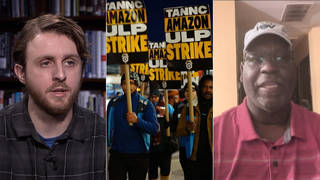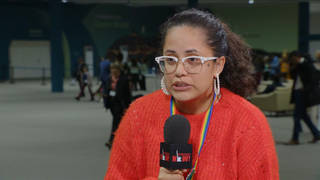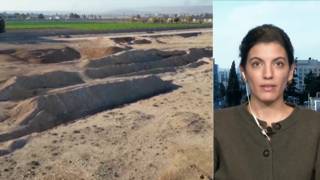
Related
We air a video news release featuring Raskin funded by Panasonic, Namco and Techno Source and talk to the “Internet Mom” Robin Raskin about the ethics behind video news releases, why she doesn’t disclose her corporate ties on her broadcasts or websites and how even many news programmers question whether their newscasts should feature corporate-sponsored features. [includes rush transcript]
The Center for Media and Democracy’s new report a “Fake TV News: Widespread and Undisclosed” highlights the work of a video news release discussing best and worst high-tech gifts for children of 2005. Portions of it aired on several stations including WPGH Channel 13 in Pittsburgh.
The report reads:
In it, technology expert and “Internet Mom” Robin Raskin warned parents about two potentially dangerous items on the market while praising four that are safe and fun for kids.
What WPGH viewers didn’t know is that the story was actually a video news release (VNR) created by D S Simon Productions and jointly funded by Panasonic, Namco and Techno Source. By no coincidence, all of the products Raskin recommends-the Oxyride battery, the Pac-Man and We Love Katamari games, and the Coleco retro gaming system-come from either Panasonic, Namco or Techno Source.
Even more insidious, the two products Raskin deems unsafe-Apple’s Video iPod and Tiger Telematics’ Gizmondo handheld gaming device-are direct commercial competitors of two of the three VNR sponsors. Panasonic offers a rival line of MP3 players while Techno Source battles Tiger Telematics in the handheld gaming market.
By itself, this VNR is little more than a tri-company infomercial that plugs numerous products while trashing its competitors. And yet when laundered through credibility of TV journalism, viewers are deceived into thinking they’re watching an independent news report with an impartial consumer expert.
Of the seven stations who incorporated the VNR into their newscasts, none disclosed the funding source of the story…
In addition to the VNR, Raskin appeared live in a satellite media tour (SMT), a coordinated series of remote interviews in which a subject interacts directly with the station anchors. The SMT, like the VNR, was coordinated by D S Simon Productions on behalf of Panasonic, Namco and Techno Source. Two stations, KGUN-9 (Tucson, AZ) and WBRC-6 (Birmingham, AL), ran the live SMT without informing viewers that Raskin’s appearance was funded by the makers of the very products she was praising.
In a moment we will speak to Robin Raskin herself but first we play one of her video news release.
- Video news release on the best and worst high-tech gifts for children of 2005. It was created by D S Simon Productions and jointly funded by Panasonic, Namco and Techno Source.
We are joined now on the program by Robin Raskin.
- Robin Raskin, she is the former editor in chief of FamilyPC and has written extensively about technology and parenting. She now serves as a consultant to publishing and high tech companies and has appeared in several video news releases. She also runs the website RobinRaskin.com
[See Part I of DN’s Fake TV News Special and Part III]
Transcript
JUAN GONZALEZ: As we continue our discussion about video news releases, we turn now to a VNR released last year about holiday gift ideas.
NARRATOR: Before you hit the stores this holiday season, technology experts warn some of the best gifts have the potential to go bad.
ROBIN RASKIN: One of the scariest examples is Apple’s new iPod Nano. It’s capable of video, and now there’s pornography all over the internet.
NARRATOR: It’s called iPorn, and hundreds of websites are selling it or offering it for free for the new video iPods.
CONCERNED MOTHER: Parents may not realize, you know, exactly what they are getting their kids.
NARRATOR: Another example is the new gaming system, Gizmondo.
ROBIN RASKIN: It has a G.P.S. system built in it so friends can find other friends and play with them. That means intruders can be there, too.
NARRATOR: And even track down your kids.
CONCERNED MOTHER: It’s very, very frightening.
NARRATOR: So what types of safe alternatives are parents turning to?
ROBIN RASKIN: I predict that one of the things parents are going to like are the retro games, and Coleco from Techno Source has 12 different arcade games bundled into one.
NARRATOR: Another comeback from the '80s is Pac-Man, but he's reinvented in the 25th anniversary game, and this time he talks.
PAC-MAN: Did someone say cake?
NARRATOR: You’ll also see more games with plotlines and Asian inspirations.
ROBIN RASKIN: One of the great things this year is the influence of Japanese artwork on games. In We Love Katamari, kids get to roll a ball around, picking up all sorts of whimsical items as they attempt to restore the universe.
NARRATOR: Raskin says after picking a great gift, you may also want to add accessories.
ROBIN RASKIN: Well, people are buying digital cameras, but they’re thinking about megabytes and megapixels, and they should be thinking about battery life. In a manufacturers test, we found that the Panasonic Oxyride, a brand-new battery with new technology, gets at least double the number of photos, digital still photos, compared to Panasonic’s original alkaline batteries.
AMY GOODMAN: We’re joined now on the phone by Robin Raskin, who appeared in that video news release. Robin Raskin is the former editor-in-chief of the magazine Family PC She’s written extensively about technology and parenting and now appears in some video news releases. We welcome you to Democracy Now!, Robin Raskin.
ROBIN RASKIN: Thanks, Amy. Thanks for having me.
AMY GOODMAN: It’s good to have you with us. So, you’re identified as a technology consultant by the local newscast. Who were you working for when you made this VNR?
ROBIN RASKIN: When I make a VNR, I’m working for — and I think you took from two different ones, but the people who — Panasonic and Namco, the people who are, you know, represented as examples of good technology. And so, you know, I have been pretty upfront actually in my VNR life, in telling both stations and [inaudible] people as I can exactly what I do, that I’m a technology expert and spokesperson, which was a very conscientious decision on my part after my last magazine closed, and I said I had to broaden my interests and do different things, really to support my family and to support and expand my career.
JUAN GONZALEZ: But now, when the news organizations, the local stations, play these, they almost never identify you as someone working for the companies. Do you have any concerns about how they are, in essence or in effect, misrepresenting the VNRs that they are getting?
ROBIN RASKIN: I do. I mean, I have so many concerns, I could write a book of concerns. You know, I actually — stepping back from my concerns for a moment, I don’t think there’s a line in that that would have been different, no matter who paid me, to do it, whether a station paid me or whether they paid me, but that’s actually beside the point. I think that the stations should call me a spokesperson, which I am. And I think that they should identify me as a spokesperson.
I don’t pretend to be a journalist in those instances. I don’t — I’m very careful not to do anything in my life now that would be perceived as journalism. I don’t write for my P.C. magazine, where I was the editor, anymore, because I don’t review products. When I do write about technology, it’s to educate, not to say this is the best, this is the worst. So I’m very careful. I do a lot of public speaking. I try to do what I do and what I made a very conscious effort to do, I tried to do it as best I can. And, yes, do I think there’s something in the report to be learned? Absolutely.
AMY GOODMAN: Robin Raskin, I want to ask you about what are known as satellite media tours. I know you did a number of live interviews during newscasts, on behalf of Panasonic, Namco and Techno Source. Let’s play a clip of your appearance on KGUN Channel 9 in Tucson, Arizona.
KGUN ANCHOR 1: The latest and greatest high-tech gadgets are on many wish lists this coming Christmas.
KGUN ANCHOR 2: Yeah, I got a few myself. The only problem, how do you tell if they are good or not? Tech expert Robin Raskin joins us now with tips. So, you have your list, you’re checking it twice, all that kind of stuff?
ROBIN RASKIN: Yeah, and interesting this year, it wasn’t that there are so many bad products. It’s like the things that can happen with your good products are kind of the astounding, like I’m shocked this year. So, I’ll give you the best example. Everybody has one of these on their gift list for somebody?
KGUN ANCHOR 2: Oh, yeah, an iPod.
KGUN ANCHOR 1: Sure, iPod. I love them.
ROBIN RASKIN: Well, no sooner did they announce the iPod Nano, the video one, there was scores of iPorn everywhere.
KGUN ANCHOR 2: Oh, yuck!
ROBIN RASKIN: It’s become a pedophile’s playground, and so parents really need to know. If you’re going give your kids an iPod, you must go on and check it to make sure — this stuff is free. It’s on Apple iTunes. It’s not like they’re hiding it anywhere. So, it’s just a whole new thing to watch for.
AMY GOODMAN: That was a clip of an interview our guest, Robin Raskin, gave to KGUN Channel 9 in Tucson, Arizona. This new study from the Center for Media and Democracy criticized the interview, because viewers were never informed that you were being funded by the makers of the very products you were praising. Your response, Robin Raskin?
ROBIN RASKIN: Oh, you know, if I had my druthers, yes, the viewers would be informed. And I certainly do the best I can to inform the stations and, you know, as I’ve said before, make no bones about what I do. I use products as examples to educate viewers. And I would use those same products regardless. I’m very careful about how I choose my products. That said, do I wish the stations would do a better job of identifying? Absolutely.
JUAN GONZALEZ: Well, I would like to follow up the issue of disclosure. On your own website, robinraskin.com, you’ve published a column called “The Best and the Worst of the Holidays 2005,” and you’ve posted a video file of the related news releases. But you don’t appear to disclose the fact that you’re being paid by these companies to promote their items. The closest to a disclosure you come is a small disclaimer at the bottom of one page that reads, “These broadcasts are sponsored by their participants. For more information, contact robin@robinraskin.com.”
ROBIN RASKIN: Right. Yes. And if you read my bio, it says I consult for various companies. And I consult in various ways. I do speaking engagements live. I do websites. I do white papers. I give my opinion on bringing products to market. So, I think that —- I think in some ways, and I won’t call it journalism, there is a message that is personality-driven. I’ll give you an example. Let’s take an Arthur Frommer. Certainly, you know, there are things that Arthur does that sort of are both sides of the line, but if you take examples like that, I think there’s a journal—- I’m not going to use the word “journalism” — I think there is a messaging that is a valid message, and I think, you know, you disclose it as best that you can. Could I do better? Possibly.
AMY GOODMAN: Let’s turn now to the co-authors of the study, to Diane Farsetta and to Daniel Price, who are in the Washington studio. Diane, your response to Robin Raskin.
DIANE FARSETTA: Well, I guess I would start off by saying that in the material that we did see coming out of the broadcast P.R. firms, there was disclosure funding in the opening and closing slates. But I would say, you know, it’s a question of where — there’s a lot of places where responsibility lies. The main recommendation of our report is actually for any provided or sponsored video, there should be continuous on-screen disclosure, and that would deal with some of the concerns that are being raised here.
I would say one of the satellite media tours, not the one that you showed, but another one — Robin Raskin was actually the overlay, the text overlay — in January of this year called her a tech journalist. So, you know, again that’s where she was identified to the viewing audience actually as a journalist. And I think just lastly, one thing to point out about the video news release that you did play about the holiday gifts, the two products that Robin warned people about, the Apple iPod and the Gizmondo handheld gaming product, were products of competitors of the companies that had funded that segment. So, I would be interested in hearing Robin’s explanation of that.
ROBIN RASKIN: Well, thanks, Diane. First of all, I appreciate what you have done. And the irony in all of this is I don’t think you could have done your report unless people like myself disclosed what they were doing, because we disclose it with every release that we send out to a station, saying we’re available. We disclose it in many different ways throughout the process over and over again, so that there’s no mistake about it.
I don’t know that I would call the iPod and Gizmondo competitors of the other products I talk about. And actually, through my segments, all the time, I bring in other products who are — who can help — if the anchor were to ask me a question, I answer as honestly as I can, whether it’s about the product that’s being — that I’m a paid representative for or not. I’m an expert in technology, and I try and bring that expertise in a very fair uniform way to all the products that I talk about. So if I were there talking about these three, but you asked me about the iPod, you know, I would answer as honestly and as best I could. And that doesn’t change. As I said, that’s sort of separate to the argument of should there be ongoing disclosure.
I think there will be movement. I think that the industry is changing. I think you’re looking at not just television, but what’s happening on the internet, too. But I think there’s room for messaging on many different sides, as long as you are transparent and honest about what you do.
DIANE FARSETTA: Would you support our call for a continuous on-screen disclosure of video news-sponsored video news releases and satellite media tours?
ROBIN RASKIN: Oh, I fight so many other battles, I’m not sure I want to get in, you know, this one, but, yes, I think it makes a lot of sense, honestly. I do. The segments that I have been the happiest with are when I’ve actually worked hand in hand with a company; for example, when Microsoft and I worked together to create an internet safety message, when Verizon and I worked together to actually explain to people how to use voice over the internet voices services. And I worked on — worked with some of the paid telephones which I thought were a great answer to keep children on a phone plan. So I think that every instance when I’ve actually worked with a company, I am very proud of those segments.
And I’m also very proud of being a spokesperson in the technology industry. I think it’s a great industry that by and large tries to educate people, and television is one of those ways. I do think your report is important. And I do think that it should be paid attention to and, you know, I hope by coming on this program, I’m kind of letting another side of it be known. There is disclosure. There is every attempt made to make it an educational segment that shows products in the appropriate light. And that’s where I feel like my part of the job comes in.
JUAN GONZALEZ: I would like to ask Daniel Price, Barbara Cochran, the head of the Radio-Television News Directors Association, has said in the past that this whole issue of video news releases is akin to the Loch Ness monster, that it’s more hyped than real. Your response, after finishing this report, as to whether the Loch Ness monster is alive and breathing?
DANIEL PRICE: Well, we managed to find 98 of them without really looking that hard. It was very, very easy. We had just a small sample of video news releases to work from. We searched for a total of 88 of them, and out of those, 36 wound up getting used in newscasts deceptively, that’s without any form of disclosure whatsoever to viewers. So — and that’s 98 instances spread out over 36 video news releases. So, if that’s a Loch Ness monster then we’ve got a lot of them out there.
AMY GOODMAN: Robin Raskin, have you ever had a conversation with a host of a local newscast who identifies you as an internet mom or a technology expert or a producer of a program, and said “I really feel you should say, ’I’m a paid Pentagon’ — rather, ’I’m a paid Panasonic spokesperson’”?
ROBIN RASKIN: Not on-air discussions. But certainly — certainly it’s a subject that’s debated off the air. And, you know, after you — I mean, you know the people that you work with, and it’s a hotly debated subject. And I really think stations — you know, I’m not a station. I don’t want to get second-guessed what they are thinking, but I know that they have certain pressures and things that they have to do.
AMY GOODMAN: What if they said off the air, when you say, 'You should identify me for who I am. I'm representing a company. When I put down iPod, I’m representing its competitor.’
ROBIN RASKIN: You know, I think if I could sort of, you know, talk about the character of the conversations, we wrestle more with the fact of what’s the right thing to do. And nobody’s made a clear decision. So, it’s like, 'Jane, this has come up. You know, we're figuring out what to do.’ And as you know, some stations have said this segment is funded, and that’s absolutely, you know, fine and desirable, in my book. The [inaudible] is funded, and a number of stations, probably more and more are doing that. And, you know, as I said about the study, the study almost couldn’t have been done if there hadn’t been disclosure, because that’s how you find out these things are being done. This is a very publicly open thing that this is a funded segment.
AMY GOODMAN: But it’s not public on the newscasts. They don’t often identify you as being a paid representative of a company. But let me ask, we are talking about corporate VNRs. There’s already been a big expose on government VNRs. Have you ever done work for the government, in reading a transcript that one of the agencies has put out?
ROBIN RASKIN: I did — I served on the National Academy of Sciences Committee, and we did a report on internet safety. And I did a satellite media tour, not a VNR, where I spoke live to stations, but that’s pretty standard for them to, once they have a report, to have a spokesperson work to issue.
AMY GOODMAN: And were you identified as a government spokesperson?
ROBIN RASKIN: As a member of the committee, which I was.
AMY GOODMAN: Robin Raskin, I want to thank you very much for joining us, for talking about the work you do, making these video news releases. And Daniel Price, I want to thank you as well, co-author of the study for the Center for Media and Democracy. Diane Farsetta, I would like to ask you to stay. We will also be joined by a commissioner of the F.C.C. to hear what the F.C.C. is considering doing about the issue of disclosure in corporate and government VNRs.












Media Options